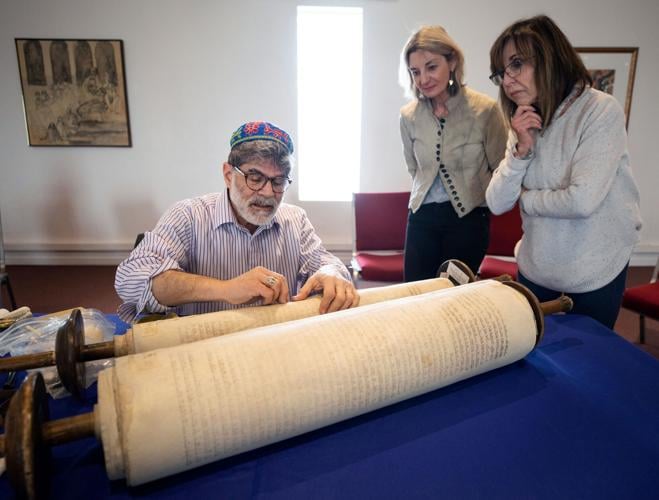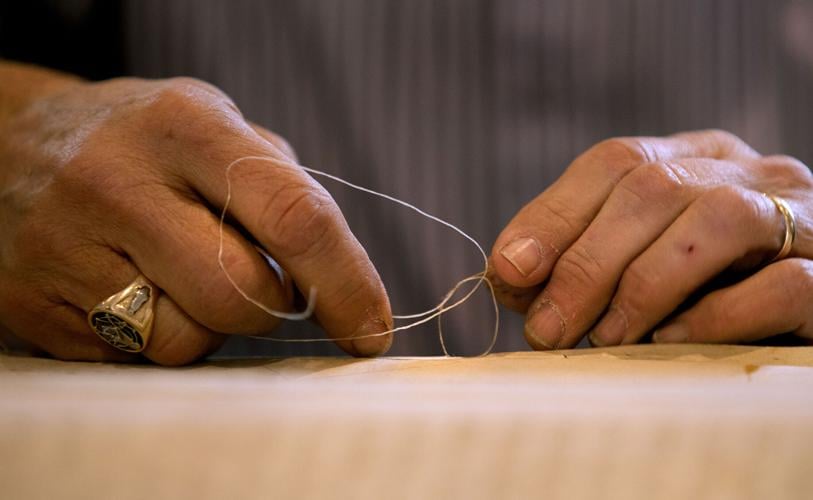A Tucson congregation’s 250-year-old Torah scroll was visited by a Jewish scribe this week for restoration.
Congregation Chaverim welcomed Rabbi Kevin Hale, of Boston, who was hired on to restore its Czech Holocaust Sefer Torah scroll during a series of events over the last week leading up to Saturday, International Holocaust Remembrance Day.
The congregation received Sefer Torah #531 from the Memorial Scrolls Trust of London, England, in 1976. It was one of more than 1,500 Torah scrolls saved by a museum in Prague ahead of Nazi invasion during World War II. These scrolls, and other valuable artifacts, were rescued from synagogues in Bohemia, Moravia and Czechoslovakia.
Based on its construction and the materials used, the scroll is believed to be about 250 years old, or about as old as the United States’ Declaration of Independence, said Ann ReVelle, a Congregation Chaverim board member who co-coordinated events this week and the restoration project.
After the war, those 1,560 scrolls were discovered in a warehouse, and when an art dealer brought them to the attention of the Westminster Synagogue, a deal was made to purchase them from then-Czechoslovakia, establishing the Memorial Scrolls Trust of London, according to ReVelle and Rabbi Hale.
“For 47 years we have cared for, read from, and cherished this scroll. We have used this scroll during our dor v’dor (from generation to generation) processions at b’nai mitzvah ceremonies, on Mt. Lemmon on Rosh Hashanah, and at many Shabbats and other services,” the congregation says on its website.
This Torah scroll was permanently loaned to the congregation and will remain there for as long as they are organized and practicing.
“The Sefer Torah was slated by the Nazis to be part of the museum of the dead race,” the Congregation wrote. “We are not a dead race; this Sefer Torah was saved and has found a home in our Aron HaKodesh, our Holy Ark, for the past fifty years. But we must now restore it to its former beauty.”
The scroll was used by the congregation until 2020, ReVelle said, when it was deemed no longer kosher. In synagogues, scrolls that cannot be restored to a state deemed kosher are no longer used, as a kosher status indicates the Torah scroll is restored to its highest quality possible.
“I saw a Torah that was in relatively good condition for this collection. It needs cleaning, it needs patching, it needs sewing. There are many, many letters that are faded, or flaking, and I’ll be rewriting them. But in a way, the bones, so to speak, are really good,” Hale said. “And it was written by one scribe, the same handwriting all the way through. (It’s) beautiful, and has characteristics of that region, essentially Bavaria, Moravia, with here and there fascinating little mystical twists on some letters.”
The Torah contains 304,805 letters, and the work needed to restore this is likened to museum conservation, Hale said.
“They’re grouped into words, and there’s spaces in the texts, and there’s some letter large and some small,” Hale said. “All of this is part of the scribal heritage. If you have a printed Bible, you have all the words, but there’s something different about this, (because) it’s written by hand.”
A grant from the Jewish Philanthropies of Southern Arizona allowed for Hale’s work to be done. His visit to Tucson, and subsequent restoration efforts, were part the congregation’s events held ahead of International Holocaust Remembrance Day.
That marks the date when the Auschwitz concentration camp was liberated by the Soviet Union. While Rabbi Hale’s feeling on the exact date is a bit “ambivalent,” he believes it serves well for “non-victims.”
“It’s very important, but I kind of feel like, yeah but where were you before that date?” Rabbi Hale asked. “Honestly, I think it’s a day of remembrance, but I think it’s kind of a day of remorse, for the nations. It is the one remembrance of the Holocaust that’s about, I mean essentially, the allies arrived too late. ... This is a day of remembrance that I think calls on non-victims to think about, ‘how did we culpably let this happen, and would we act differently in a different time?’”
Throughout the week, Hale mended and restored the scroll while teaching its history, the history of the Holocaust and how to restore such an old piece, giving the “opportunity to experience Torah at a physical, cultural and religious level” at various events around Tucson, the congregation said.
The Torah scroll will travel back east with Rabbi Hale, where he will continue the restoration process. It’s expected to be back in Congregation Chaverim’s hands by April, ReVelle said, and a celebration of that momentous day is expected once it has been returned.
“There’s something about Torah that keeps on affirming life, it certainly keeps on affirming that Jewish people are living,” Rabbi Hale said. “I called a dear friend from college, who lives in Israel, a few days after (Oct. 7), to ask her what’s needed. ... She said ‘Kevin, there’s three things: pray, give tzedakah (donations), and write Torah.’ At first, I took that to mean you’ve got to go on with your life. But I think it’s deeper. I think what we’re doing is following her on a communal level, and it’s very life-affirming, even in the most sad time.”
“We keep on being in this publishing partnership with God, and it’s intrinsically hopeful.”





